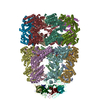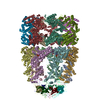+ Open data
Open data
- Basic information
Basic information
| Entry | Database: EMDB / ID: EMD-1046 | |||||||||
|---|---|---|---|---|---|---|---|---|---|---|
| Title | ATP-bound states of GroEL captured by cryo-electron microscopy. | |||||||||
 Map data Map data | GroEL with GroES and ADP bound to one ring, and ATP bound to the other ring | |||||||||
 Sample Sample |
| |||||||||
| Function / homology |  Function and homology information Function and homology informationGroEL-GroES complex / chaperonin ATPase / virion assembly / : / isomerase activity / protein folding chaperone / ATP-dependent protein folding chaperone / response to radiation / unfolded protein binding / protein folding ...GroEL-GroES complex / chaperonin ATPase / virion assembly / : / isomerase activity / protein folding chaperone / ATP-dependent protein folding chaperone / response to radiation / unfolded protein binding / protein folding / protein-folding chaperone binding / response to heat / protein refolding / magnesium ion binding / ATP hydrolysis activity / ATP binding / metal ion binding / identical protein binding / membrane / cytosol / cytoplasm Similarity search - Function | |||||||||
| Biological species |  | |||||||||
| Method | single particle reconstruction / cryo EM / Resolution: 23.5 Å | |||||||||
 Authors Authors | Saibil HR | |||||||||
 Citation Citation |  Journal: Cell / Year: 2001 Journal: Cell / Year: 2001Title: ATP-bound states of GroEL captured by cryo-electron microscopy. Authors: N A Ranson / G W Farr / A M Roseman / B Gowen / W A Fenton / A L Horwich / H R Saibil /  Abstract: The chaperonin GroEL drives its protein-folding cycle by cooperatively binding ATP to one of its two rings, priming that ring to become folding-active upon GroES binding, while simultaneously ...The chaperonin GroEL drives its protein-folding cycle by cooperatively binding ATP to one of its two rings, priming that ring to become folding-active upon GroES binding, while simultaneously discharging the previous folding chamber from the opposite ring. The GroEL-ATP structure, determined by cryo-EM and atomic structure fitting, shows that the intermediate domains rotate downward, switching their intersubunit salt bridge contacts from substrate binding to ATP binding domains. These observations, together with the effects of ATP binding to a GroEL-GroES-ADP complex, suggest structural models for the ATP-induced reduction in affinity for polypeptide and for cooperativity. The model for cooperativity, based on switching of intersubunit salt bridge interactions around the GroEL ring, may provide general insight into cooperativity in other ring complexes and molecular machines. | |||||||||
| History |
|
- Structure visualization
Structure visualization
| Movie |
 Movie viewer Movie viewer |
|---|---|
| Structure viewer | EM map:  SurfView SurfView Molmil Molmil Jmol/JSmol Jmol/JSmol |
| Supplemental images |
- Downloads & links
Downloads & links
-EMDB archive
| Map data |  emd_1046.map.gz emd_1046.map.gz | 7.6 MB |  EMDB map data format EMDB map data format | |
|---|---|---|---|---|
| Header (meta data) |  emd-1046-v30.xml emd-1046-v30.xml emd-1046.xml emd-1046.xml | 11.5 KB 11.5 KB | Display Display |  EMDB header EMDB header |
| Images |  1046.gif 1046.gif | 26.7 KB | ||
| Archive directory |  http://ftp.pdbj.org/pub/emdb/structures/EMD-1046 http://ftp.pdbj.org/pub/emdb/structures/EMD-1046 ftp://ftp.pdbj.org/pub/emdb/structures/EMD-1046 ftp://ftp.pdbj.org/pub/emdb/structures/EMD-1046 | HTTPS FTP |
-Validation report
| Summary document |  emd_1046_validation.pdf.gz emd_1046_validation.pdf.gz | 198.3 KB | Display |  EMDB validaton report EMDB validaton report |
|---|---|---|---|---|
| Full document |  emd_1046_full_validation.pdf.gz emd_1046_full_validation.pdf.gz | 197.5 KB | Display | |
| Data in XML |  emd_1046_validation.xml.gz emd_1046_validation.xml.gz | 5.4 KB | Display | |
| Arichive directory |  https://ftp.pdbj.org/pub/emdb/validation_reports/EMD-1046 https://ftp.pdbj.org/pub/emdb/validation_reports/EMD-1046 ftp://ftp.pdbj.org/pub/emdb/validation_reports/EMD-1046 ftp://ftp.pdbj.org/pub/emdb/validation_reports/EMD-1046 | HTTPS FTP |
-Related structure data
| Related structure data |  1gruMC  1042C  1047C  1gr5C  2c7eC M: atomic model generated by this map C: citing same article ( |
|---|---|
| Similar structure data |
- Links
Links
| EMDB pages |  EMDB (EBI/PDBe) / EMDB (EBI/PDBe) /  EMDataResource EMDataResource |
|---|---|
| Related items in Molecule of the Month |
- Map
Map
| File |  Download / File: emd_1046.map.gz / Format: CCP4 / Size: 7.8 MB / Type: IMAGE STORED AS FLOATING POINT NUMBER (4 BYTES) Download / File: emd_1046.map.gz / Format: CCP4 / Size: 7.8 MB / Type: IMAGE STORED AS FLOATING POINT NUMBER (4 BYTES) | ||||||||||||||||||||||||||||||||||||||||||||||||||||||||||||||||||||
|---|---|---|---|---|---|---|---|---|---|---|---|---|---|---|---|---|---|---|---|---|---|---|---|---|---|---|---|---|---|---|---|---|---|---|---|---|---|---|---|---|---|---|---|---|---|---|---|---|---|---|---|---|---|---|---|---|---|---|---|---|---|---|---|---|---|---|---|---|---|
| Annotation | GroEL with GroES and ADP bound to one ring, and ATP bound to the other ring | ||||||||||||||||||||||||||||||||||||||||||||||||||||||||||||||||||||
| Projections & slices | Image control
Images are generated by Spider. | ||||||||||||||||||||||||||||||||||||||||||||||||||||||||||||||||||||
| Voxel size | X=Y=Z: 2.8 Å | ||||||||||||||||||||||||||||||||||||||||||||||||||||||||||||||||||||
| Density |
| ||||||||||||||||||||||||||||||||||||||||||||||||||||||||||||||||||||
| Symmetry | Space group: 1 | ||||||||||||||||||||||||||||||||||||||||||||||||||||||||||||||||||||
| Details | EMDB XML:
CCP4 map header:
| ||||||||||||||||||||||||||||||||||||||||||||||||||||||||||||||||||||
-Supplemental data
- Sample components
Sample components
-Entire : GroES-ADP7-GroEL-ATP7 from E.coli
| Entire | Name: GroES-ADP7-GroEL-ATP7 from E.coli |
|---|---|
| Components |
|
-Supramolecule #1000: GroES-ADP7-GroEL-ATP7 from E.coli
| Supramolecule | Name: GroES-ADP7-GroEL-ATP7 from E.coli / type: sample / ID: 1000 Details: The complexes were prepared by pre-forming a GroEL-GroES-ADP complex, with 100 uM ADP, then adding an excess of single ring GroEL (SR1) to trap any released GroES; then 1 mM ATP was added. ...Details: The complexes were prepared by pre-forming a GroEL-GroES-ADP complex, with 100 uM ADP, then adding an excess of single ring GroEL (SR1) to trap any released GroES; then 1 mM ATP was added. Any GroEL-GroES complexes remaining have ADP in the GroES-bound ring and ATP in the other ring, modelling the in vivo ATP-binding reaction. Oligomeric state: 14-mer / Number unique components: 2 |
|---|---|
| Molecular weight | Experimental: 1 MDa / Theoretical: 1 MDa |
-Macromolecule #1: GroEL
| Macromolecule | Name: GroEL / type: protein_or_peptide / ID: 1 / Name.synonym: Chaperonin 60 / Number of copies: 1 / Oligomeric state: 14-mer / Recombinant expression: Yes |
|---|---|
| Source (natural) | Organism:  |
| Molecular weight | Experimental: 800 KDa / Theoretical: 800 KDa |
| Recombinant expression | Organism:  |
-Macromolecule #2: GroES
| Macromolecule | Name: GroES / type: protein_or_peptide / ID: 2 / Name.synonym: Chaperonin 10 / Number of copies: 1 / Oligomeric state: 7-mer / Recombinant expression: Yes |
|---|---|
| Source (natural) | Organism:  |
| Molecular weight | Experimental: 70 KDa / Theoretical: 70 KDa |
| Recombinant expression | Organism:  |
-Experimental details
-Structure determination
| Method | cryo EM |
|---|---|
 Processing Processing | single particle reconstruction |
| Aggregation state | particle |
- Sample preparation
Sample preparation
| Concentration | 0.8 mg/mL |
|---|---|
| Buffer | pH: 7.5 Details: 12.5 mM HEPES, 5 mM KCl, 5 mM MgCl2, 100 uM ADP, then 2x molar excess of single ring mutant of GroEL (SR1), then 1 mM ATP just before vitrification. See sample details for an explanation of ...Details: 12.5 mM HEPES, 5 mM KCl, 5 mM MgCl2, 100 uM ADP, then 2x molar excess of single ring mutant of GroEL (SR1), then 1 mM ATP just before vitrification. See sample details for an explanation of the experimental design. |
| Grid | Details: holey carbon film |
| Vitrification | Cryogen name: ETHANE / Chamber temperature: 100 K / Instrument: HOMEMADE PLUNGER / Details: Vitrification instrument: self made Timed resolved state: The sample was vitrified within a few seconds of manually mixing in ATP. Method: Blot for 1 second before plunging |
- Electron microscopy
Electron microscopy
| Microscope | FEI TECNAI F20 |
|---|---|
| Temperature | Average: 105 K |
| Image recording | Category: FILM / Film or detector model: KODAK SO-163 FILM / Digitization - Scanner: ZEISS SCAI / Digitization - Sampling interval: 14 µm / Number real images: 71 / Average electron dose: 20 e/Å2 / Od range: 1 / Bits/pixel: 8 |
| Electron beam | Acceleration voltage: 200 kV / Electron source:  FIELD EMISSION GUN FIELD EMISSION GUN |
| Electron optics | Illumination mode: FLOOD BEAM / Imaging mode: BRIGHT FIELD / Cs: 2 mm / Nominal defocus max: 3.0 µm / Nominal defocus min: 0.9 µm / Nominal magnification: 50000 |
| Sample stage | Specimen holder: Eucentric / Specimen holder model: GATAN LIQUID NITROGEN |
| Experimental equipment |  Model: Tecnai F20 / Image courtesy: FEI Company |
- Image processing
Image processing
| CTF correction | Details: CTF multiplication and merging of 2D averages |
|---|---|
| Final reconstruction | Applied symmetry - Point group: C7 (7 fold cyclic) / Algorithm: OTHER / Resolution.type: BY AUTHOR / Resolution: 23.5 Å / Resolution method: FSC 0.5 CUT-OFF / Software - Name: Spider / Details: Filtered back projection / Number images used: 1448 |
| Final angle assignment | Details: Full coverage around a single axis, using mainly side views |
-Atomic model buiding 1
| Initial model | PDB ID: |
|---|---|
| Software | Name: Manual fitting in O |
| Details | Protocol: Rigid body. The only movement relative to the crystal structure of GroEL-ES-ADP seen at this resolution is a twist of the free apical domains. |
| Refinement | Space: REAL / Protocol: RIGID BODY FIT |
| Output model |  PDB-1gru: |
 Movie
Movie Controller
Controller












 Z (Sec.)
Z (Sec.) Y (Row.)
Y (Row.) X (Col.)
X (Col.)






















